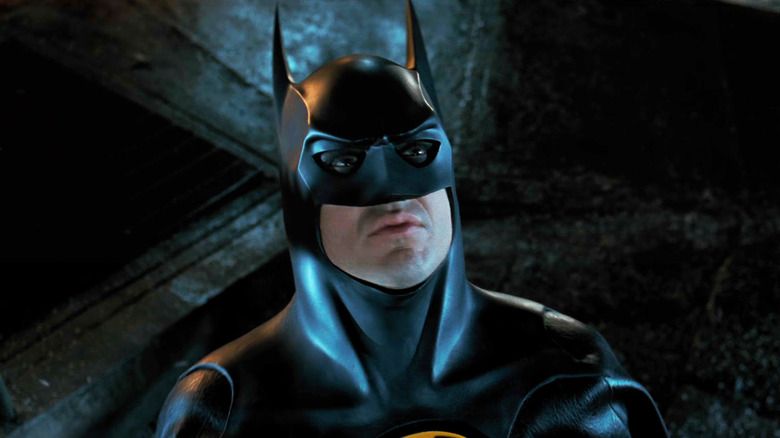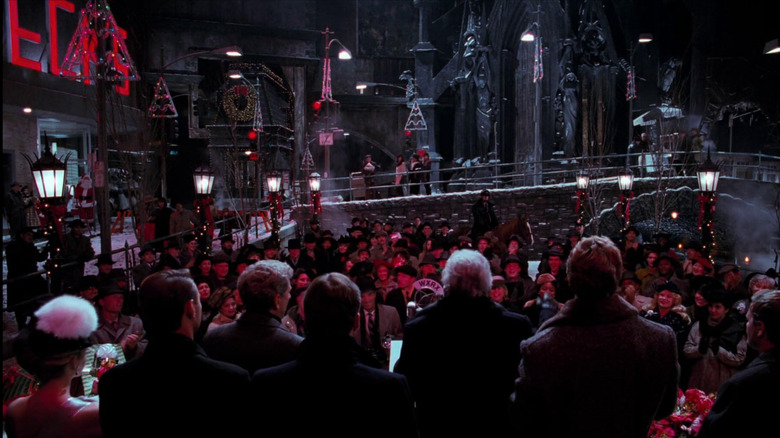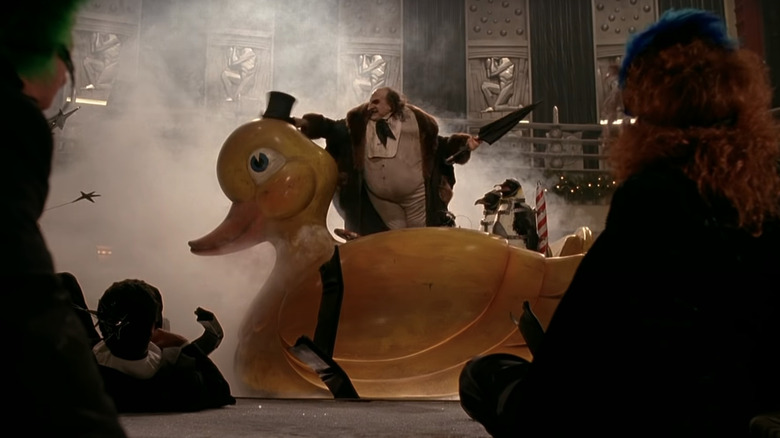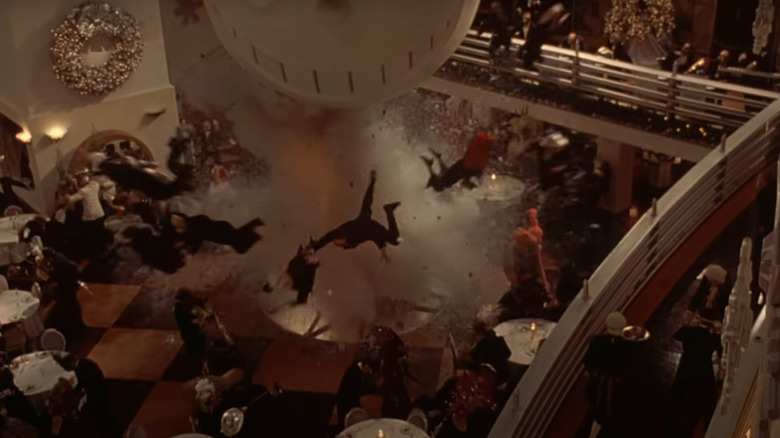One Of Batman Returns' Most Intense Scenes Broke An Explosive World Record
You might say it's a miracle that Tim Burton's "Batman" was ever made, considering the director's unusually dark vision and the multitude of issues faced by the production. Indeed, Burton referred to the process of making his 1989 blockbuster as "torture," citing all manner of hurdles, from rewrites to grueling all-night shoots, and even a fall out with Carl Grissom actor Jack Palance, who evidently felt the young filmmaker was in no position to give any authoritative direction.
But at least Burton was somewhat shielded from the surprisingly virulent backlash that followed Michael Keaton's casting in the lead role. Thankfully, the movie was shooting at the UK's famed Pinewood Studios, and thus Burton and co. weren't subjected to the full force of the furor that was brewing stateside. Pinewood also offered more than shelter from controversy. The Buckinghamshire studio's giant backlot allowed Burton and production designer Anton Furst to construct a giant 600 ft high Gotham City set, on which they were free to race Batmobiles and crash Batwings to their hearts' content.
For the sequel, however, Burton wouldn't have the luxury of filming on Pinewood's expansive backlot. Instead, 1992's "Batman Returns" was shot on the equally prestigious Warner Bros. sound stages in Burton's hometown of Burbank, CA. While the Warner lot provided more than enough space across its various warehouses, it did force production designer Bo Welch and his crew to build Gotham in sections. But that was a tiny issue in comparison to the numerous other challenges the crew would face on "Returns." Ultimately, the production would prove to be almost as difficult as "Batman" — at least logistically.
Reimagining Gotham
Bo Welch's Gotham remains, in my opinion, the greatest on-screen Gotham we've ever had. Melding fascist architecture with typical yet exaggerated elements of a quintessential American city — and, of course, Tim Burton's expressionist style — the Gotham of "Batman Returns" was a beguiling, dingy wonderland of oppressive neo-classic design. No wonder Burton is still proud of his movie more than 30 years later.
But it took a lot to bring it to fruition. The massive sound stages needed cooling with inordinate amounts of air conditioning equipment to make the actors' breath visible and create the illusion of a Gotham City in the midst of the Christmas season. That, and the dozens of real-life penguins used in the movie couldn't be left to swelter in the Burbank heat (the movie shot during the summer of '91). Unfortunately, on numerous occasions, crew left stage doors open which would let all the chilled air escape. Add to that the necessity to constantly have Gotham blanketed in snow during the height of a Los Angeles summer, and you get a sense of just how many considerations the crew was juggling.
On top of the temperature issues, the "Batman Returns" team was tasked with conducting some fairly significant explosions on the sound stages themselves. At 65 ft high, stage 16 was the tallest on the Warner Bros. lot and played host to Gotham city exteriors, including the Shreck department store, owned by Christopher Walken's nefarious businessman Max Schreck. Impressive though it was, this storefront would be blown up during production in service of depicting Catwoman (Michelle Pfeiffer)'s destructive antics.
Oswald's dramatic entrance
The destruction of the Shreck storefront wasn't the only explosion the "Returns" crew had to carry out on a soundstage. Late in the movie, Oswald Cobblepot/Penguin — a little too committed Danny DeVito — blows up a dance floor of a building in order to crash the masquerade ball being held inside. Supervising Art Director Tom Duffield estimated that this interior was the second largest set in the movie and recalled how the team had designed the whole thing in a streamlined Art Deco style. Which is why it was kind of a shame they had to blow the whole thing up.
For his dramatic entrance to the masquerade ball, Oswald explodes the dance floor and ascends through the smoke on a giant yellow duck. In the official movie book for "Batman Returns," Special Effects Supervisor Chuck Gaspar recalled how the interior blast was "a lot more challenging" than the exterior version due to the fact that there were "real people standing right on top of it." Special Effects Foreman Mike Edmonson added:
"The only way this scene would really work is if it looked like the floor itself drove the people up into the air. So the stunt people had a great idea ... let's get as many people in there as we can, hook 'em up to ratchets and cables, and yank them into the air when the floor goes up!"
Burton then selected 14 stunt performers who would be attached to cables and harnesses that would allow them to be "ratcheted" into the air as if they'd been thrown skyward as a result of the explosion. But to actually pull it off while the cameras were rolling would take some focused preparation and a bit of luck.
'We had to have it right on the first take'
After a week of rehearsals, Burton shot the interior explosion scene with only one chance to get things right. As Chuck Gaspar recalled, "We didn't get a chance to rehearse the floor. You can only blow it up once. We had to have it right on the first take, because it was a very expensive shot to think about redoing." Mike Edmonson elaborated on the techniques used to make the detonation seem more believable:
"We used half-inch tempered glass for the dance floor, which would easily support the stuntplayer/dancers' weight. Then, about six feet underneath them, we placed about eight 20 inch x 20 inch conical mortars, filled with broken tempered glass. Then we had a couple of black powder bombs to create a little bit of smoke in the area after the floor goes up."
Thankfully, everything mostly worked as it should, with the stunt performers all being ratcheted a second before the explosion hit. However, according to AFI, the 10 October 1991 issue of DV, "reported that four stuntmen were treated for minor injuries after a planned explosion that took place during the filming of a scene at Shreck's department store." Perhaps predictably, the official movie book for "Batman Returns" makes no mention of any injuries, stating instead that, "the timing was absolutely perfect. The shot went off like a dream." Whatever injuries there were must have been fairly minor for the book to gloss over them. Otherwise, the explosion not only represented a triumph of planning and stunt coordination, it also achieved a record for the most number of people ever ratcheted at one time. Not bad for a film that also ushered in the franchise era.



